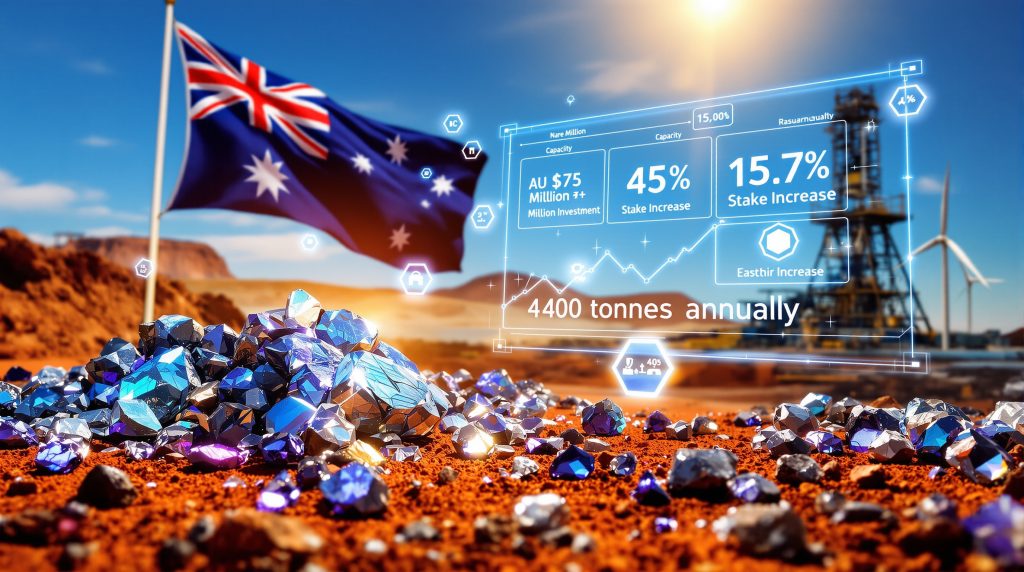Understanding the Strategic Move Behind Hancock's 15.7% Stake
Hancock Prospecting lifts stake in Arafura Rare Earths marks a pivotal moment in Australia's critical minerals landscape. The mining giant's decision to increase its shareholding from approximately 10% to 15.7% through a substantial AU$475 million capital raise demonstrates unprecedented confidence in the rare earth sector's future prospects.
This strategic investment positions Hancock Prospecting as a major stakeholder in what could become Australia's most significant rare earth operation outside of the established Mount Weld facility. Furthermore, the timing of this expansion coincides with global supply chain vulnerabilities and increasing Western demand for critical mineral independence, aligning with Australia's broader critical minerals strategy.
Breaking Down the AU$475 Million Capital Raise Structure
The capital raising structure reveals sophisticated financial engineering designed to minimise market disruption whilst maximising funding efficiency. The two-tranche placement approach allows for staged capital deployment, reducing immediate dilution pressure on existing shareholders.
| Placement Component | Value (AU$ Million) | Share Price | New Shares (Billion) |
|---|---|---|---|
| Tranche 1 | 285 | 0.28 | 1.02 |
| Tranche 2 | 190 | 0.28 | 0.68 |
| Total | 475 | 0.28 | 1.70 |
The AU$0.28 per share pricing represents a carefully calculated balance between attracting institutional investment and maintaining existing shareholder value. This pricing strategy reflects current market conditions whilst providing sufficient discount to incentivise large-scale participation from sophisticated investors.
Market analysts suggest the pricing incorporates a modest discount to recent trading averages, typical for placements of this magnitude. In addition, the introduction of 1.7 billion new shares significantly expands Arafura's capital base, providing substantial financial flexibility for project development phases.
From 10% to 15.7%: Calculating Hancock's Growing Commitment
Hancock Prospecting's AU$125 million investment to increase its stake represents one of the largest single commitments to Australian rare earth development in 2025. This expansion demonstrates strategic conviction beyond typical portfolio diversification, suggesting long-term operational involvement expectations.
Key Investment Metrics:
- Previous stake: ~10%
- New stake: 15.7%
- Investment amount: AU$125 million
- Strategic significance: Potential board influence and operational input
The timing of this stake increase coincides with Arafura's progression toward final investment decision, scheduled for early 2026. Consequently, Hancock's commitment during this critical development phase provides significant validation for the project's technical and commercial viability.
Comparative analysis with other major rare earth investments in 2025 reveals this transaction ranks among the top three private sector commitments globally, excluding Chinese domestic investments. The strategic nature of the investment suggests potential operational synergies beyond pure financial returns.
Why Is the Nolans Project Attracting Billionaire Investment?
The Nolans project's appeal extends beyond traditional mining economics, encompassing strategic resource security and technological innovation. Located in the Northern Territory, this integrated rare earth operation promises to deliver critical materials essential for clean energy transition and defence applications.
Production Capacity That Could Reshape Australia's Position
The Nolans project targets 4,400 tonnes annual NdPr oxide production capacity, positioning it as a globally significant supplier of these critical permanent magnet materials. This output level would establish Australia as a major non-Chinese source of neodymium-praseodymium oxides, essential for electric vehicle motors and wind turbine generators.
The project's 38-year mine life projections provide exceptional long-term value creation potential, far exceeding typical mining project horizons. This extended operational timeline offers investors sustained cash flow generation and strategic resource security across multiple economic cycles.
| Production Metric | Nolans Target | Current Australian Output | Global Significance |
|---|---|---|---|
| NdPr Oxide (tonnes/year) | 4,400 | 2,800* | ~8% of global supply |
| Mine Life | 38 years | Varies | Extended stability |
| Integrated Processing | Yes | Limited | Supply chain control |
*Lynas Corporation approximate current production
The integrated processing capability distinguishes Nolans from typical mining operations, incorporating separation and refining technologies that capture additional value along the supply chain. Furthermore, this vertical integration reduces dependence on Chinese processing facilities, addressing critical Western supply chain vulnerabilities.
Critical Minerals Strategy: Beyond Traditional Mining
Australia's national critical minerals reserve identifies rare earths as essential for economic security and technological sovereignty. The Nolans project aligns directly with government objectives to establish reliable, ally-friendly supply chains for strategic materials.
Government support mechanisms include:
- Export Finance Australia backing for qualified projects
- Critical Minerals Facility funding availability
- Fast-track approval processes for strategic developments
- Tax incentives for critical mineral operations
- Research and development collaboration opportunities
Supply chain diversification away from Chinese dominance represents a geopolitical imperative for Western nations. However, recent supply disruptions and export restrictions have highlighted the strategic vulnerability of single-source dependencies for critical materials.
The Northern Territory location provides logistical advantages through established mining infrastructure and proximity to Asian markets. Darwin's port facilities offer direct shipping access to key customer regions whilst maintaining operational independence from southern Australian infrastructure constraints.
How Does This Investment Impact Australia's Rare Earth Landscape?
Hancock Prospecting lifts stake in Arafura Rare Earths transforms the competitive dynamics within Australia's emerging rare earth sector. This substantial investment validates the sector's potential whilst establishing new benchmarks for project financing and development approaches.
Market Position Analysis: Where Arafura Stands Post-Investment
The significant capital injection positions Arafura as a tier-one development company within Australia's rare earth hierarchy. With strengthened financial backing and strategic partnership potential through Hancock's involvement, the company gains substantial competitive advantages.
| Company | Project Status | Target Production | Key Advantages |
|---|---|---|---|
| Lynas Corporation | Operating | 5,500+ tonnes REO | Established operations |
| Arafura (Post-investment) | Development | 4,400 tonnes NdPr | Strategic backing, integrated processing |
| Iluka Resources | Development | 1,200 tonnes REO | Heavy rare earth focus |
| Northern Minerals | Early development | 400 tonnes heavy REE | Specialised products |
Market share projections for 2026-2030 suggest Arafura could capture approximately 25-30% of Australian rare earth production once operational. This market position would establish the company as a significant global supplier outside traditional Chinese dominance.
The post-investment landscape creates potential for industry consolidation or strategic partnerships. For instance, Hancock's increased stake might facilitate operational synergies or supply chain integration opportunities with other portfolio companies or strategic partners.
Technology Sector Implications: Meeting Clean Energy Demand
Critical Application Areas for NdPr Oxides:
- Electric vehicle motors (highest grade permanent magnets)
- Wind turbine generators (high-efficiency power generation)
- Industrial automation systems (precision motor applications)
- Defence technology systems (specialised magnetic components)
Global demand forecasts for rare earth permanent magnets project 8-12% annual growth through 2030, driven primarily by electric vehicle adoption and renewable energy expansion. This demand trajectory significantly exceeds current non-Chinese supply capacity, creating substantial market opportunities.
Australia's potential role in Western supply chain security extends beyond raw material provision. The integrated processing capabilities planned for Nolans could establish Australia as a critical link in advanced manufacturing supply chains, reducing dependence on Chinese processing facilities.
Technology sector partnerships represent significant value creation opportunities. In addition, direct supply agreements with automotive manufacturers or renewable energy companies could provide revenue stability whilst supporting strategic customer relationships.
What Are the Financial Implications for Investors?
The AU$475 million capital raise fundamentally alters Arafura's financial profile, transforming the company from a development-stage entity to a well-funded project developer approaching commercial viability. This financial strengthening creates both opportunities and considerations for various investor categories.
Cash Position Strengthening: From Risk to Opportunity
Post-placement cash reserves of AU$584 million provide substantial financial flexibility for project development and operational preparedness. This cash position exceeds many established mining companies and positions Arafura among the best-funded development projects globally.
| Funding Milestone | Estimated Cost (AU$ Million) | Timeline | Risk Level |
|---|---|---|---|
| Final Investment Decision | 50-75 | Early 2026 | Low |
| Construction Phase 1 | 250-300 | 2026-2027 | Medium |
| Commissioning & Ramp-up | 100-150 | 2027-2028 | Medium-High |
| Working Capital Reserve | 150-200 | Ongoing | Low |
Risk mitigation strategies benefit from this strengthened financial position. Extended cash runway reduces execution risk and provides buffer capacity for potential cost overruns or market volatility impacts during development phases.
The funding structure eliminates immediate refinancing pressure, allowing management to focus on operational execution rather than capital raising activities. Consequently, this operational focus historically correlates with improved project delivery outcomes and stakeholder confidence.
Share Dilution vs. Strategic Value Creation
The introduction of 1.7 billion new shares creates immediate dilution for existing shareholders, reducing their percentage ownership whilst potentially enhancing absolute value through improved project viability. This dilution-value trade-off requires careful evaluation of long-term wealth creation potential.
AU$50 million Share Purchase Plan allocation for retail investors provides existing shareholders partial participation opportunities in the capital raise. This allocation demonstrates management's commitment to existing shareholder interests whilst accommodating institutional investment requirements.
Valuation implications of Hancock's premium investment suggest sophisticated due diligence and strategic conviction. Institutional investors of Hancock's calibre typically conduct extensive technical and commercial analysis before committing substantial capital to development projects.
The market's initial response to this investment announcement will provide insights into broader investor sentiment toward Australian rare earth development and investment strategy fundamentals.
When Will the Nolans Project Reach Production?
Project development timelines reflect the complexity of establishing integrated rare earth processing operations whilst maintaining realistic commercial objectives. The progression toward final investment decision represents a critical milestone in transforming the project from development concept to operational reality.
Timeline to Final Investment Decision in Early 2026
Key development milestones remaining before final investment decision include:
- Definitive Feasibility Study completion and optimisation
- Environmental approval finalisation from Northern Territory government
- Major customer off-take agreement execution
- Detailed engineering and construction contractor selection
- Final project financing arrangements confirmation
- Board approval and investment commitment authorisation
Regulatory approval pathways in the Northern Territory benefit from established mining frameworks and government support for critical mineral projects. The Territory government's proactive approach to strategic developments typically accelerates approval processes compared to other jurisdictions.
Infrastructure development requirements include processing facility construction, tailings management systems, and transportation logistics integration. However, the relatively developed Northern Territory mining infrastructure reduces some traditional greenfield development challenges.
Production Ramp-Up Projections and Market Entry
| Development Phase | Timeline | Production Level | Key Milestones |
|---|---|---|---|
| Construction Completion | Late 2027 | 0% | Facility commissioning |
| Initial Production | Early 2028 | 25% | Process optimisation |
| Ramp-up Phase 1 | Mid 2028 | 50% | Customer qualification |
| Ramp-up Phase 2 | Late 2028 | 75% | Full market entry |
| Steady State Production | 2029 | 100% | Target capacity achieved |
Export logistics benefit from Darwin's established port infrastructure and existing shipping relationships with Asian markets. Container and bulk shipping options provide operational flexibility for different product specifications and customer requirements.
Customer agreement status remains commercially sensitive, though industry sources suggest preliminary discussions with major automotive and renewable energy companies. Securing anchor customers before production commencement significantly reduces market entry risks.
Revenue generation forecasts for initial years depend heavily on rare earth pricing dynamics and production ramp-up efficiency. Conservative estimates suggest AU$400-600 million annual revenue at steady-state production, assuming current market pricing levels.
How Does This Compare to Global Rare Earth Investment Trends?
The Hancock Prospecting investment aligns with accelerating global trends toward rare earth supply chain diversification and strategic mineral security. Western governments and private investors increasingly recognise the economic and security implications of Chinese market dominance in critical materials.
Western World's Response to Supply Chain Vulnerabilities
Major Non-Chinese Rare Earth Investments in 2025:
- United States: Mountain Pass expansion and processing capabilities
- Canada: Multiple development projects with government backing
- Europe: Processing facility development and strategic partnerships
- Australia: Expanded production capacity and integrated processing
Government policy support across allied nations creates favourable investment conditions for rare earth development. The United States Defence Production Act, European Critical Raw Materials Act, and Australia's Critical Minerals Strategy collectively provide billions in potential funding and incentives.
Strategic mineral partnership developments include the Minerals Security Partnership, encompassing major Western economies committed to supply chain diversification. These partnerships facilitate project financing, technical collaboration, and market access for qualifying developments.
The geopolitical dimension of rare earth investment extends beyond commercial considerations, incorporating national security and economic sovereignty objectives. This strategic imperative supports premium valuations and patient capital deployment for qualifying projects.
Investment Scale Analysis: AU$475 Million in Context
| Investment Type | 2025 Global Total | Average Project Size | Geographic Focus |
|---|---|---|---|
| Rare Earth Development | AU$2.1 billion | AU$350 million | Australia, North America |
| Lithium Projects | AU$8.7 billion | AU$450 million | Global |
| Critical Mineral Processing | AU$1.8 billion | AU$275 million | Western nations |
Private versus government investment ratios in rare earth development favour private capital, though government support mechanisms provide crucial risk mitigation. The Arafura investment represents predominantly private sector commitment with potential government backing availability.
Return on investment projections for strategic metals benefit from supply-demand imbalances and geopolitical risk premiums. Industry analysis suggests rare earth projects may achieve 15-25% internal rates of return under current market conditions and pricing assumptions.
The scale of the Hancock investment positions it among the largest private sector commitments to Australian rare earth development, demonstrating institutional confidence in both the specific project and broader sector fundamentals.
What Risks and Opportunities Lie Ahead?
Whilst the substantial investment provides significant development momentum, various technical, market, and regulatory challenges require ongoing management attention. Success depends on effective risk mitigation and capitalising on emerging opportunities within the rapidly evolving rare earth landscape.
Technical Development Challenges for Nolans
Processing technology complexities for integrated rare earth operations require specialised expertise and proven methodologies. The separation and purification processes demand precise chemical engineering and environmental management systems to achieve commercial viability.
Environmental compliance requirements encompass waste management, water usage optimisation, and ecosystem impact minimisation. Northern Territory environmental standards require comprehensive monitoring and reporting systems throughout operational phases.
Key technical milestones to monitor include:
- Pilot plant performance validation and optimisation
- Metallurgical testing results for commercial-scale processing
- Environmental management system implementation
- Safety protocol development and workforce training
- Quality control systems for product specification compliance
- Maintenance and operational efficiency optimisation
Community engagement requirements extend beyond regulatory compliance to include ongoing stakeholder relationships and local economic benefits. Successful mining operations increasingly depend on maintaining positive community relationships throughout project lifecycles.
Market Dynamics: Demand Growth vs. Supply Competition
Global NdPr oxide demand growth projections range from 8-15% annually through 2030, driven primarily by electric vehicle adoption and renewable energy infrastructure development. This demand trajectory significantly exceeds current supply expansion plans outside China.
Competitive threats from other emerging producers require ongoing market positioning and customer relationship management. Projects in development across North America, Africa, and other Australian locations create potential oversupply scenarios in outer years.
Price volatility considerations reflect the relatively small size of rare earth markets compared to major base metals. Supply disruptions or demand surges can create significant price movements, requiring robust financial planning and risk management strategies.
Market concentration risks persist despite supply diversification efforts. Chinese producers maintain dominant market positions and potential influence over global pricing dynamics, requiring careful strategic planning and customer relationship development.
Frequently Asked Questions About Hancock's Arafura Investment
What percentage of Arafura does Hancock Prospecting now own?
Following the AU$475 million placement, Hancock Prospecting holds approximately 15.7% of Arafura Rare Earths. This represents an increase from their previous stake of around 10%, achieved through participation in the capital raising at AU$0.28 per share.
The exact shareholding percentage depends on the final allocation of shares and any additional investments through the retail share purchase plan. Voting rights associated with this stake provide Hancock with significant influence over major corporate decisions and strategic direction.
Board representation implications remain subject to shareholder agreement terms and company governance structures. Large shareholders of this magnitude typically seek board positions or advisory roles to protect their investment interests and provide strategic input.
How does this investment align with Gina Rinehart's broader strategy?
The rare earth investment represents strategic diversification beyond Hancock Prospecting's traditional iron ore focus, positioning the company across multiple critical mineral sectors. This diversification strategy reduces commodity concentration risk whilst capitalising on global supply chain transformation trends.
Rinehart's strategic metals portfolio development approach emphasises long-term value creation and strategic resource control rather than short-term trading opportunities. This patient capital approach aligns well with rare earth project development timelines and market characteristics.
The investment timing coincides with global recognition of critical mineral security importance, suggesting strategic positioning for potential government partnerships and long-term supply agreements with major industrial customers.
What makes the Nolans project unique among rare earth developments?
| Unique Feature | Nolans Advantage | Industry Comparison |
|---|---|---|
| Integrated Processing | Full value chain control | Most projects mining only |
| Deposit Grade | High-quality ore body | Variable across projects |
| Geographic Location | Stable jurisdiction, infrastructure | Many in remote locations |
| Product Focus | High-value NdPr oxides | Mixed rare earth products |
The Northern Territory location provides exceptional stability and infrastructure advantages compared to many international rare earth developments. Established mining services, skilled workforce availability, and government support create favourable operational conditions.
Technical advantages include favourable ore mineralogy and processing characteristics that support integrated operations. The ability to control the entire value chain from mining through refined product delivery provides significant competitive advantages and margin optimisation opportunities.
Australia's Rare Earth Renaissance Through Strategic Investment
The Hancock Prospecting investment in Arafura represents more than financial backing; it symbolises Australia's emergence as a critical player in global rare earth supply chain transformation. This strategic commitment demonstrates private sector confidence in Australia's potential to challenge traditional market structures.
Long-term Implications for National Resource Security
Key Takeaways for Australia's Critical Minerals Strategy:
- Private sector validation of government strategic objectives
- Demonstration of commercial viability for integrated operations
- Establishment of Australia as reliable alternative supplier
- Foundation for advanced manufacturing supply chain development
Integration with allied nation supply chain initiatives positions Australia as a cornerstone of Western critical mineral security architecture. The successful development of projects like Nolans creates precedents for additional strategic mineral developments across the continent.
Economic development potential for the Northern Territory extends beyond direct project employment and revenue. Successful rare earth operations can attract related industries, research facilities, and advanced manufacturing capabilities, creating broader economic multiplier effects.
The investment validates Australia's approach to critical mineral development, combining private sector efficiency with strategic government support. In conclusion, this model may inform future development strategies across multiple critical mineral sectors essential for clean energy transition and technological advancement, supporting Australia's green metals leadership position.
As global supply chains continue evolving toward greater resilience and strategic security, Australia's rare earth sector appears positioned to capture significant value whilst supporting broader national and allied strategic objectives. The Hancock investment represents a foundational step in this strategic transformation, reflecting the broader mining industry evolution toward strategic mineral focus.
Ready to Capitalise on the Next Major ASX Mineral Discovery?
Discovery Alert's proprietary Discovery IQ model delivers instant notifications when significant mineral discoveries hit the ASX, transforming complex geological data into actionable investment opportunities before the broader market reacts. See how historic major discoveries can generate exceptional returns and begin your 30-day free trial to position yourself ahead of strategic moves like Hancock's AU$475 million commitment to Arafura.




